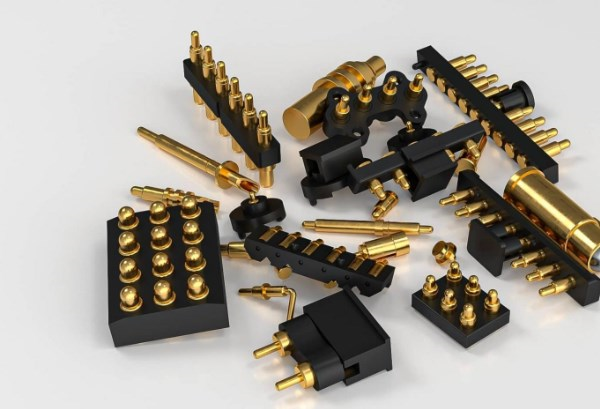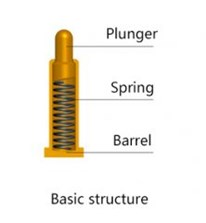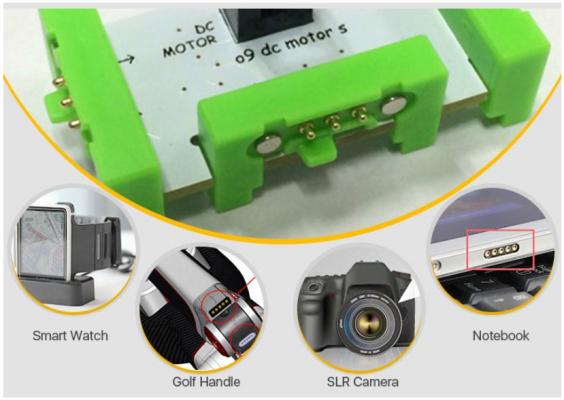Pogo pins, also known as spring-loaded contacts or spring-loaded connectors, are mechanical components used to establish temporary electrical connections between two points. These pins comprise a spring-loaded mechanism encapsulated within a metal housing, featuring a sharp conducting tip at one end. Pogo pins are commonly employed in various applications where frequent or temporary electrical connections are required, such as testing fixtures, programming adapters, battery connectors, and more.
Key characteristics of pogo pins include:
-
Spring-Loaded Mechanism: Pogo pins utilize a spring-loaded design that allows the pins to compress when pressure is applied and subsequently retract to establish a connection when the pressure is released.
-
Single-Pin Design: Each pogo pin functions as an individual electrical contact, capable of providing a reliable electrical pathway between two points.
-
Versatility: Pogo pins come in various sizes, shapes, and configurations to accommodate different applications, providing flexibility in design and usage.
-
Durability: Typically constructed from materials like brass, gold, or stainless steel, pogo pins offer durability and longevity, making them suitable for repetitive use cases.
-
High Current and Voltage Handling: Pogo pins can be designed to handle various current and voltage levels depending on the application requirements.
Applications of pogo pins include:
-
Test and Measurement: Used in test fixtures and probe systems to establish temporary connections for testing electronic components or printed circuit boards (PCBs).
-
Programming and Debugging: Pogo pins are utilized in programming adapters and debugging interfaces to establish quick and reliable connections with programming headers on PCBs.
-
Battery Contacts: Commonly employed in battery compartments of electronic devices to provide a reliable electrical connection between the battery and the device.
-
Interconnect Solutions: Pogo pins are also used in various interconnect solutions where temporary connections are necessary, such as docking stations, wearable devices, and more.
In summary, pogo pins are versatile components that play a crucial role in establishing temporary electrical connections in a wide range of applications, offering durability, reliability, and ease of use in various industries and projects.

How Does A Pogo Pin Work
Pogo pins, also known as spring-loaded contacts, work on a simple yet effective engineering principle. These components feature a spring-loaded mechanism enclosed within a metal housing, with a sharp conducting tip at one end. The function of a pogo pin can be understood through the following steps:
-
Spring-Loaded Mechanism: The key element of a pogo pin is the spring-loaded mechanism inside. This mechanism allows the pin to compress and retract, enabling it to establish an electrical connection when it comes into contact with a counterpart.
-
Compression and Extension: When pressure is applied to the pogo pin, the spring inside compresses, allowing the conducting tip to retract into the housing. This compression enables the pogo pin to absorb shocks or variations in alignment without losing contact.
-
Establishing Electrical Connection: As the external pressure is released, the spring inside the pogo pin pushes the conducting tip forward, extending it out of the housing. This extension brings the conducting tip into contact with the target pad, connector, or surface, establishing an electrical connection between the two points.
-
Conductivity and Signal Transmission: The conducting tip of the pogo pin is typically made of materials like brass or gold that offer good electrical conductivity. This conducting tip ensures a reliable contact point for transmitting signals, power, or data between devices or components.
-
Reliability and Performance: Pogo pins are designed to provide a secure and reliable connection even in environments with vibrations, movements, or variations in alignment. Their spring-loaded design allows them to maintain consistent contact pressure, ensuring stable electrical connections.
-
Multiple Pins (when used in arrays): In applications where multiple connections are required, pogo pins are often used in arrays or clusters. Each individual pogo pin in the array functions independently, allowing for multiple connections to be established simultaneously.
By utilizing the spring-loaded mechanism and the conducting tip design, pogo pins offer a practical solution for establishing temporary or repeatable electrical connections in various applications such as test fixtures, programming adapters, battery contacts, interconnect solutions, and more. Their reliability, durability, and ease of use make them versatile components in electronics testing, manufacturing, and other industries.

How to Properly Use Pogo Pins
Properly using pogo pins involves a series of steps to ensure effective and reliable electrical connections. Here is a guide on how to use pogo pins correctly in your applications:
-
Select the Right Pogo Pins: Choose pogo pins that match your specific requirements in terms of size, current rating, spring force, and application needs.
-
Prepare Your Work Area: Ensure your work surface is clean and free of debris that could interfere with the pogo pin connections.
-
Prepare the Target Device: Clean the target device's contact pads or connectors to ensure a clean and conductive surface for the pogo pins to make contact.
-
Proper Alignment: Align the pogo pins correctly with the target pads or connectors on the PCB or device you are working with to establish precise connections.
-
Apply Even Pressure: When inserting the pogo pins into the target device, apply even pressure to ensure that all pins make good contact simultaneously.
-
Testing the Connection: After inserting the pogo pins, perform a continuity test using a multimeter to verify that each pin is making proper contact with its corresponding pad.
-
Securing the Pogo Pins: If needed, secure the pogo pins in place using a fixture, clamps, or other mechanisms to prevent movement during testing or operation.
-
Perform Functional Tests: Once the pogo pins are secured, conduct functional tests on the device to ensure that the connections made by the pogo pins are stable and reliable.
-
Maintenance and Cleaning: Regularly inspect and clean the pogo pins to remove any dirt, debris, or oxidation that may affect their performance. Ensure the springs are intact and functioning correctly for consistent connectivity.
-
Consider Current and Voltage Requirements: Ensure that the selected pogo pins can handle the current and voltage requirements of your specific application to prevent any electrical issues or damage.
By following these steps, you can effectively use pogo pins in your projects, testing procedures, programming interfaces, or any application that necessitates temporary electrical connections. Proper handling, alignment, and maintenance of pogo pins will help ensure stable electrical connections and maximize the lifespan of these crucial components.
Tips for Avoiding Damage to Pogo Pins During Use
To prevent damage and ensure the longevity of pogo pins during use, consider the following tips:
-
Select High-Quality Pogo Pins: Opt for high-quality pogo pins from reputable manufacturers that are designed to withstand repeated use and offer durability.
-
Proper Alignment: Ensure accurate alignment of the pogo pins with the contact pads or connectors on the target device to prevent bending or misalignment.
-
Avoid Overloading: Do not exceed the specified current and voltage ratings of the pogo pins to prevent overheating and damage.
-
Apply Even Pressure: When inserting the pogo pins, apply even pressure to prevent excessive stress on individual pins, which could lead to deformation or breakage.
-
Use Adequate Spring Force: Select pogo pins with an appropriate spring force that matches the application requirements to ensure reliable electrical connections without excessive pressure.
-
Implement Proper Securing Mechanisms: Secure the pogo pins in place during testing or operation using fixtures, clamps, or other methods to prevent unintended movement or stress on the pins.
-
Avoid Extreme Temperatures: Protect pogo pins from exposure to extreme temperatures that could affect the integrity of the materials or compromise the spring mechanism.
-
Regular Cleaning and Maintenance: Clean and inspect the pogo pins regularly to remove any dirt, debris, or oxidation that could impact their performance. Ensure the springs are functioning correctly.
-
Choose the Right Plating Material: Select pogo pins with appropriate plating (such as gold) to enhance conductivity, prevent corrosion, and maintain a reliable connection over time.
-
Monitor for Signs of Wear: Periodically check for signs of wear, such as deformation, corrosion, or loss of spring force, and replace any damaged pogo pins promptly.
-
Avoid Excessive Vibrations or Shock: Minimize exposure to excessive vibrations or mechanical shock that could compromise the integrity of the pogo pins.
By following these tips and best practices, you can help prevent damage to pogo pins during use, maintain their effectiveness, and extend their lifespan in various applications that require reliable electrical connections.

What Are Pogo Pins Used for
Pogo pins, also known as spring-loaded contacts, are used in a variety of applications where temporary or frequent electrical connections need to be established reliably. Here are some common uses of pogo pins:
-
Test and Measurement Equipment: Pogo pins are extensively used in testing fixtures and test setups to create temporary electrical connections between test points on printed circuit boards (PCBs) and testing equipment. They enable efficient testing of electronic components and circuits.
-
Programming and Debugging Interfaces: Pogo pins are employed in programming adapters and debugging interfaces to make quick and reliable connections with programming headers on PCBs. They facilitate programming and debugging tasks in electronics manufacturing and development.
-
Battery Contacts: Pogo pins are commonly used in battery compartments of devices such as smartphones, remote controls, and wearables to establish electrical connections with batteries. They provide a reliable and convenient solution for battery insertion and removal.
-
Interconnect Solutions: Pogo pins are utilized in interconnect solutions, such as docking stations, IoT devices, wearables, and connectors, to create temporary or movable electrical connections. They allow for easy and quick connections between devices.
-
Docks and Connectors: Pogo pins are employed in docking stations for smartphones, tablets, and other devices, providing a reliable and convenient way to establish connections for charging, data transfer, and other functionalities.
-
Aviation and Aerospace Applications: Pogo pins are used in the aerospace industry for applications like avionics testing, satellite communication systems, and other mission-critical systems that require secure electrical connections.
-
Automotive Electronics: Pogo pins find applications in automotive electronics for testing sensors, control modules, and other electronic components during manufacturing and servicing processes.
-
Medical Devices: In medical device manufacturing, pogo pins are utilized for testing and quality control purposes. They help ensure the functionality and reliability of electronic systems incorporated in medical devices.
-
Robotics and Automation: Pogo pins are used in robotics and automated systems for testing and maintenance tasks, enabling efficient and reliable electrical connections in these dynamic environments.
-
Wearable Technology: Pogo pins are integrated into wearable devices, such as smartwatches and fitness trackers, to establish connections for charging, data transfer, and accessories like heart rate monitors.
In summary, pogo pins play a vital role in various industries and applications where temporary, reliable, and repeatable electrical connections are required. Their versatility, durability, and ease of use make them essential components in electronics testing, manufacturing, and development processes.
Using pogo pins effectively involves a series of steps to ensure proper connectivity and reliable performance. Here are nine steps to guide you through the process of using pogo pins:
-
Select the Correct Pogo Pins: Choose pogo pins that are compatible with your specific application in terms of size, shape, current rating, and spring force.
-
Prepare Your Work Area: Ensure your work area is clean and free of debris that could interfere with the pogo pin connection.
-
Prepare the Target Device: Make sure the target device or PCB is clean and free of any obstacles that could obstruct the pogo pin connection.
-
Position the Pogo Pins: Align the pogo pins correctly with the target pads or connectors on the PCB or device you are working with.
-
Apply Even Pressure: When inserting the pogo pins into the target device, apply even pressure to ensure all pins make proper contact simultaneously.
-
Test the Connection: After inserting the pogo pins, perform a continuity test using a multimeter to verify that each pin is making good contact with its corresponding pad.
-
Secure the Pogo Pins: If necessary, secure the pogo pins in place using a fixture, clamps, or other means to prevent movement during testing or operation.
-
Perform Functionality Tests: After securing the pogo pins, perform functional tests on the device to ensure that the connections made by the pogo pins are stable and reliable.
-
Maintenance and Cleaning: Regularly inspect and clean the pogo pins to remove any dirt, debris, or oxidation that may affect their performance over time. Ensure the integrity of the springs for consistent connectivity.
By following these nine steps, you can effectively use pogo pins in your projects, testing procedures, or any application that requires temporary electrical connections. Proper handling and maintenance of pogo pins will help ensure they provide reliable electrical connections and support your work effectively.



